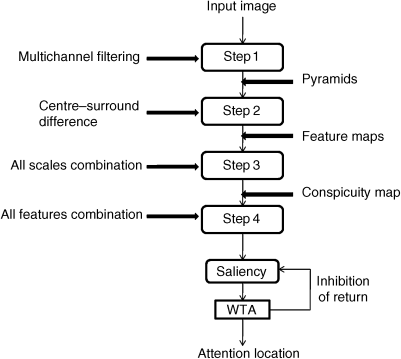3.3 Variations and More Details of BS Model
There have been lots of variations for the original baseline saliency (BS) model since 1998. Some of them change certain details in the BS model, when it is used in object recognition and computer vision of robot and so on. From the core of the BS model in Figure 3.1 the model can be divided into four main steps after image input:
Besides the four main steps, the winner-take-all (WTA) neural network connecting to the saliency map and the inhibition of return (IoR) are necessary in some applications, which was not discussed in Section 3.1. The framework of original BS with WTA is described in Figure 3.4.
Figure 3.4 Framework of BS with WTA and IoR

We will introduce first the variations to the BS model in Section 3.3.1, and then WTA and IoR in Section 3.3.2.
3.3.1 Review of the Models with Variations
There are many models with meaningful changes in each step (as mentioned above) of the original BS model. For the variations to the BS model to be discussed ...
Get Selective Visual Attention: Computational Models and Applications now with the O’Reilly learning platform.
O’Reilly members experience books, live events, courses curated by job role, and more from O’Reilly and nearly 200 top publishers.

